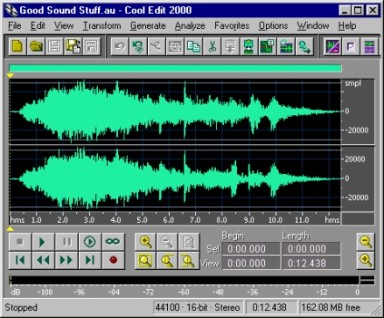
Cool Edit
Launched: 1996
Cool Edit Pro is an advanced multi-track sound editing program for Windows. It offers the following features:
- Sound filters using DSPE (Digital Signal Processing Effect).
- Multi-track functionality. Up to 64 simultaneous tracks.
- Supports plug-ins to expand its possibilities.
- Ability to create batch process files.
Syntrillium Software was founded in the early 1990s by Robert Ellison and David Johnston, both former Microsoft employees.
The first version was Cool Edit 96, weighing 2.88 MB, with audio editing, recording, and playing capabilities. It was originally released as shareware with some limited functionality, but functional, standing out among audio editors at the time.
This version was followed by Cool Edit 2000.
Syntrillium then released Cool Edit Pro, which added the ability to work with multiple tracks.
Later, Cool Edit Pro v2 added support for real-time and non-destructive processing (when the program remembers the edits and adjustments we make, without modifying the original audio file).
And in version 2.1, the last before Adobe acquired Syntrillium, it added support for surround audio mixing and support for using an unlimited number of tracks (limited only by the computer's capacity).
Cool Edit was also a pioneer, including plugins such as FFT equalization and noise reduction. Adobe acquired the program in May 2003 for $16.6 million, along with a large library of loops called "Loopology."
Version 1 of Adobe Audition was essentially the same Cool Edit Pro application under a new name. Version 1.5 was released in May 2004 with software enhancements made by Adobe, adding numerous features such as pitch correction, frequency space viewing, editing, CD project view, basic video editing, integration with Adobe Premiere Pro, and many other functions.
Version 2 was released on January 17, 2006. With this version, Audition (which the music industry had only seen as a home studio-oriented application) entered the professional DAW market. New improvements included ASIO (Audio Stream Input/Output) support, waveform editing in spectral view, VST (Virtual Studio Technology) support, new mastering tools (many provided by iZotope3), and a significantly improved graphical interface. Adobe also included the program as part of its Creative Suite Production Studio application suite, released around the time of Creative Suite 2. It was subsequently removed from Creative Suite 3, 4, and 5, being replaced by Adobe Soundbooth, a reduced, semi-professional version.
Version 3 of Adobe Audition was released in October 2007 as a standalone application, including new features such as VSTi support, convolution reverb, timestretching, and a suite of guitar effects.
Version 4, released in April 2011, was included in Creative Suite 5.5 (not CS5), where it replaced the older Adobe Soundbooth, but was also released as a standalone application. This release represented a complete rewrite of the Adobe Audition application from scratch to improve performance thanks to multi-threaded processing and also to allow for the first time a version for Mac OS X. This release included improved integration with Adobe Premiere Pro multitrack projects, the introduction of session import and export functions in OMF and XML formats, improvements in multi-channel 5.1 audio support, new effects (DeHummer, DeEsser, Speech Volume Leveler, and Surround Reverb), a History panel, faster and more comprehensive FFT analysis, and a new, more reliable and faster audio engine for non-ASIO devices.
Version 5, released in April 2012, was included in Creative Suite 6. This version was notable for allowing clip grouping and automatic alignment of voice recordings (this technology was first demonstrated as a feature of Audition in September 2011). It also allowed for faster and more precise editing, real-time clip stretching, support for EUCON and Mackie control surfaces, parameter automation, more powerful pitch correction, HD audio playback, and new effects, among other new features.
Several versions of Adobe Audition have subsequently appeared within the Adobe Creative Cloud suite of applications under the name "Adobe Audition CC" but continuing with the same version numbering system, although without mentioning the version directly in the program title (it is only visible in the application's splash screen and in the "About" window), instead using the year of release (starting with version 7).
Version 6 of Adobe Audition, titled "Adobe Audition CC," was released in June 2013. One of the most notable features of this version was that for the first time it was a native 64-bit application, allowing it to use large amounts of RAM and support 64-bit VST plug-ins. It was also the first 64-bit application in the entire Adobe Creative Cloud suite. It included new features such as a frequency-based noise remover, a new dual preview in the editor, an improved editable favorites panel, new sound design tools and effects, improved spectral waveform editing, and multiple improvements to the multitrack editor.
Version 7 of Adobe Audition, titled "Adobe Audition CC 2014," was released in June 2014. It included improved codec support, including Dolby Digital (AC3), and improvements to the multitrack editor interface, among other features.
Adobe Audition version 8, titled "Adobe Audition CC 2015" was released in June 2015. It includes new features such as video streaming from Adobe Premiere Pro with Dynamic Link, real-time asset relinking, full-screen video output (for audio editing in video), automatic session backup, improved handling of imported content, marker import and export, customizable threshold meter values, timed recording, and improved audio driver performance, avoiding sample rate mismatch errors and having better support for USB microphones.